Category Archive for South America
Space Goth fashion & Street Art in Valparaiso, Chile! Cool colorful murals, graffiti walking tour.

Space Goth Mermaid is the theme of the day… because I’m in colorful Valparaíso, Chile!
“Valpo” is a UNESCO World Heritage site, and boasts some of the best street art in the world. This hip, rainbow-covered city is only a 1.5 hour drive from Santiago — making it a perfect day trip during my LATAM Airlines adventure in South America..

If you’re an art and culture seeker, you will adore Valparaiso’s vibe. Artists from around the world flock to this Chilean port city, to add their works to this open canvas.
Walking around, you’ll come across wall-sized murals, graffiti, found art, 3D installations… sky’s the limit, when it comes to creativity in Valpo.

Santiago is a popular hub for LATAM’s many domestic and international flights. If you’re in the capital of Chile, I urge you to take a day to explore the nearby Valparaiso. It’s an inspiring place to walk around, find unexpected art (some of it with political themes), and take a million photos.
(All images by Joey Wong, other than some iPhone snaps by LC.)

How to travel here: Valparaiso is located 120 kilometers west of Santiago. To get here, we rode the metro (subway) to Santiago’s Pajaritos station, near the end of the red line. Then, we bought roundtrip tickets for the bus that leaves every 30 minutes or so for Valpo. There’s no need to book in advance, as there are plenty of seats especially on weekdays.
Two bus companies, Turbus and Pullman, travel this route for $5-10. Both are about the same price and quality; we went with Turbus, and found ourselves in a modern carrier with comfortable reclining seats. We enjoyed this view of the Chilean mountains, and napped the rest of the way. (The ride is about 1.5 hours.)

When you arrive at Valparaiso bus station, you can look for the tourist information booth in case you have questions. The staff can help you find the local bus stop outside. Ride it to Plaza Sotomayor, the large central square.
From Plaza Sotomayor, you can take the old elevators up the various hills to see street art.

Valparaiso has over 40 hills, stacked with brightly colored houses and public art. There are quite a lot of stairs and slopes, so be sure to wear comfortable shoes and bring sun protection.

I put together a “Space Gothic” outfit of the day. I combined Goth with cyber-galaxy colors that match my hair, as well as the murals around me!
I’m wearing a long Lip Service skirt and top from Salemonster (they have a large selection of alternative brand fashion, at reduced rates!). My pink cat-eye sunglasses are by Irregular Choice. This designer is known for its Rococo fabulous shoes, as you can see below…

If you aren’t keen on walking up and down hills, you can use the funicular “ascensors” built in the 19th century. There are 15 of these rickety metal elevators, which take you up the slopes for a few coins.
Some of Valparaiso’s districts can be a little sketchy (we were warned to be careful with our DSLR camera and belongings). To avoid any issues, I recommend that you stick to the main sightseeing areas. In any case, that’s where you will find most of the street art!
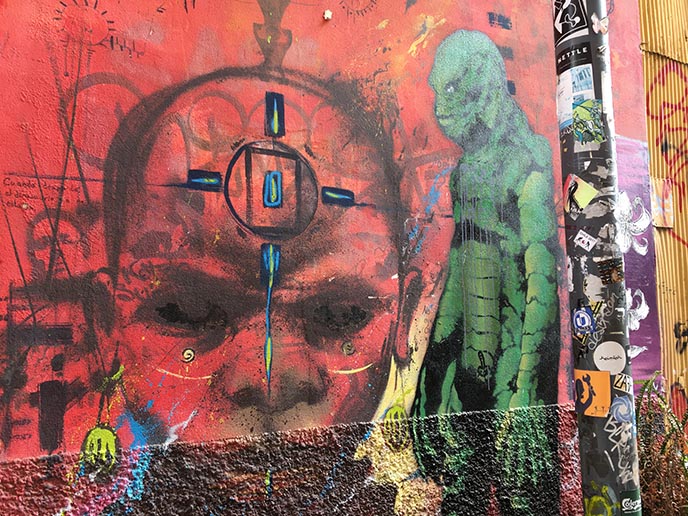
What’s the best way to get around Valparaiso? I recommend that you take the funicular or walk up El Peral. Once you reach the top, you’ll find a glorious view of the water, as well as an old palace and a fine arts museum.
From there, you can stroll around and enjoy the colorful works around you. The murals have wonderfully diverse styles and subjects. As a horror fan, I was delighted to see the Creature from the Black Lagoon!

While you will find street art all over Peral, the main streets are Monte and Cerro Alegre, Capilla, Miramar and especially Templeman.

How did Valpo become a tableau for worldwide artists? Around the 1920s, Mexico had a burgeoning muralism movement. This inspired Chilean poet / diplomat Pablo Neruda to invite artists to come to his city, and get creative.

Valparaiso was already known as the “Jewel of the Pacific” for its beautiful Pacific Ocean setting. However, now it’s best known as a laid-back, hipster destination covered head-to-toe in eclectic art. It’s a great place to art-walk, followed by a leisurely meal of empanadas and pisco sours at a local cafe.

I enjoyed seeing the contrast between old and new. Valparaiso was a major seaport in the 1800s, during Spanish Colonial times. Today, these churches and palaces stand next to quirky murals.

Many local buildings invited artists to decorate their storefronts. I was amazed at the variety of works throughout Valparaiso: from graffiti tags, to intricate portraits, to three-story narratives.

“Aliens welcome.” This sounds like my type of town!

I’m wearing a spider pin that reminded me of the one Cheryl Blossom wears in the Riverdale TV series. My spider brooch got stolen from my luggage.. but thankfully, it was only a $7 pin that I got here!
Outfit details: cyber spine skirt from Salemonster, sunglasses from Irregular Choice.

There’s so much to see in this port city with dozens of hills. Some people join a guided walking tour, in order to see the highlights. We preferred to walk around on our own, and come across gems like this ostrich by chance.

It’s impossible to see all of the paintings in Valparaiso, and artists are constantly creating new works. I enjoyed taking snaps of whatever caught my eye. A drainpipe refashioned as a cat-girl’s mouth, a studio with sculptures made with found objects.

“Herrrreeee’s Johnny!” I’m clearly surprised to see Jack Nicholson from Stanley Kubrick’s The Shining, one of my favorite horror films. (I even had the VHS tape of it, back in the 9os!)

Some of the most interesting works convey a socio-political message. This one is a graphic commentary on religion and colonialism in South America, and the oppression of native Chileans.

I was impressed by the level of talent found in Valparaiso. There’s a sense of community among the (mostly young) artists as well.

Even the streetlamps and drainpipes get a technicolor makeover.

The local government supports creators with workspaces and resources. The result: glorious murals like this one.

This serene, blue “happy hippie” face was one of my favorites. Note the greenery growing out of his ears!

Closeup on my Riverdale spider brooch from here. My silver necklace is by Aurum by Guðbjörg.
The pink sunglasses are Irregular Choice; shop more of their designs below:

Not all parts of Valparaiso are accessible for everyone. Be prepared for a lot of walking, including up and down lots of stairs.

How beautiful is this mural? If I came back to Valpo, I’d join a guided tour so that I could learn more about each specific artist.

Look out for the uniquely decorated stairs. This one looks like a kite, if you view it from a distance (see the diamond on my left). Another staircase looks like piano keys.

At the top of ascensor Peral, take a moment to enjoy this panoramic view of the city and bay.

And don’t miss out on the tiny details. Street signs, telephones and other unexpected objects get an artistic transformation here.

How sweet it must be for these local residents, living / working / studying / playing amidst these colorful creations!

These mosaic steps next to the funicular called out for a photoshoot.
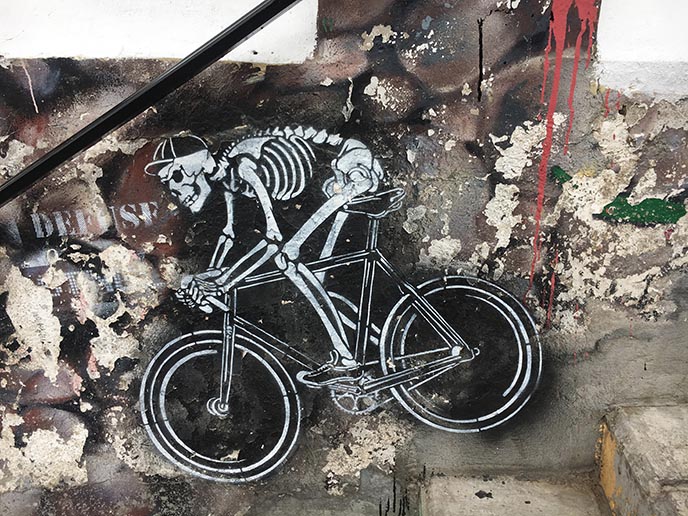
As I explored, I took snaps of skeletons and other Gothic creatures (as I thought these would be of interest to you!) Here’s a cheerful fellow riding a bike.

A smiling skull, and two Frankensteins. Is he holding a clam on his fingertip?

Some of the skeletons had an anatomical feeling.
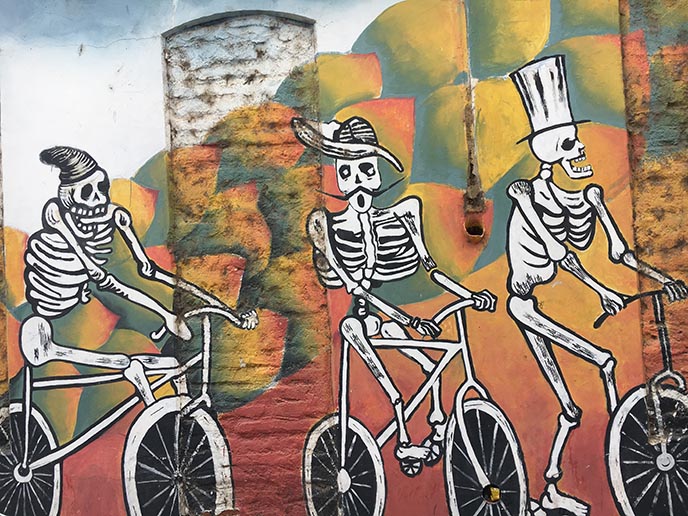
Others reminded me of the naughty Day of the Dead skeletons I saw in Tulum, Mexico.

Chile’s national poet, Pablo Neruda, adored living here. As he put it, “Valparaíso, what an absurdity you are, how crazy: a crazy port. What a head of dishevelled hills, that you never finished combing. Never did you have time to dress yourself, and always you were surprised by life.”

I think Neruda’s words sum up the eccentric atmosphere of Valparaiso today! (If you haven’t seen The Shining movie, you need to rent it.)

Isn’t this “street art city” a wonderland? Have you heard of Valparaiso before this story?
Perhaps these images may inspire you to book a flight to Chile on LATAM Airlines, and climb this rainbow staircase for yourself!
PS: if you enjoyed my space Goth outfit, here are more skeleton styles below. Click the thumbnails for details:
SHARE & COMMENT
Futuristic Architecture in Rio de Janeiro, Brazil! Museum of Tomorrow, Niemeyer UFO building, Sofitel Ipanema hotel.

If you came across a flying saucer, what would you do? Personally, I’d beam myself in!
I think you can tell I had an (inter)stellar time in Rio de Janeiro, Brazil. The city turned out to be one of my favorite stops on my LATAM Airlines trip in South America.
Rio is a laid-back destination for anyone interested in Brazilian culture, food and beach life. It’s also home to a few unexpectedly “spacey” attractions that stirred my imagination…
Read on for my alternative art / culture travel guide to RDJ. (Obrigado Rio CVB for the local assistance, and Sofitel Ipanema hotel for the beautiful stay.)

Let’s start inside my spaceship. This cosmic wonder is actually the MAC Niterói Contemporary Art Museum, designed by Brazilian architect Oscar Niemeyer.
The MAC is located across the water from Rio de Janeiro. To get here, you can take a ferry across the water, or Uber over the sleek bridge to Niteroi.

Oscar Niemeyer is the modernist genius behind over 500 structures in Brazil, including the civic buildings of the new capital Brasilia (established 1960). With white concrete and flowing curves, his architecture looks like something out of a sci-fi movie.
(My outfit is a tribute to Niemeyer’s modernism. I’m wearing a white Unique Vintage dress and silver glitter slip-on shoes.)

The stark, curving walls are the perfect setting for avantgarde art. Above is Ayrson Heraclitus’s exploration of the Afro-Brazilian Candomblé religion. Visitors hear the clank of metalwork (representing Ogun, the warrior god) over footage of worshippers cooking feijoada (a local stew presented as an offering).

My travel partner and co-photographer was Elizabeth Wurtzel (author of Prozac Nation, Bitch, and other bestselling books). We adored the “Anna Bella & Lygia & Mira & Wanda” exhibition, which put the spotlight on four leading Brazilian contemporary artists.
Above is a movable metal sculpture by Lygia Clark. In the next room, Mira Schendel’s Zen minimalist works express “transcendence from the zero spectrum” (that’s how the didactic label put it!)

Doesn’t this look like a scene from 2001: A Space Odyssey?
I was impressed by Wanda Pimentel’s fine linework; she paints women’s feet and domestic objects, in a “critique of society’s suppression of privacy.” We also loved the political art of Anna Bella Geiger, which rallied against “burocracia” and censorship during Brazil’s dictatorship.

Be sure to take in the spectacular view of Rio, from the red ramps that wrap around the flying object. You can spot Sugarloaf Mountain, Christ the Redeemer and other landmarks across Guanabara Bay.
Then, walk down the spiral staircase to the bistro, where you can drink caipirinhas and browse handmade jewelry inspired by Niemeyer.

Oscar Niemeyer is one of my architecture heroes, and I was over the moon to finally visit one of his masterpieces.
(Outfit of the day: a white retro-style dress from Unique Vintage, and sparkly slip-on shoes.)

If you’re into experimental art (and aliens!), the Museu de Arte Contemporânea de Niterói is one of the coolest museums on planet Earth.

On another day, Elizabeth and I visited Rio’s Museum of Tomorrow, which also looks like an intergalactic shuttle! Designed by Spanish architect Santiago Calatrava, the Museu do Amanhã opened in 2015 right before the Olympics.
The museum and urban plaza rejuvenated the Porto Maravilha waterfront, which was once a run-down district of Rio.

Calatrava’s innovative design looks like a spacecraft hovering over water. The silhouette was inspired by the bromelia flower, which he saw in Rio’s Botanical Gardens.

The visionary Museum of Tomorrow is unlike any other. The experience focuses on five questions: Where did we come from? Who are we? Where are we? Where are we going? And how do we want to live together over the next fifty years?
Visitors receive a touch card in their language of choice, for interacting with the displays. At the end, you can measure your consumption footprint; mine was not great, as I fly more than 100 hours a year…
(Leather wrap bracelet by Bulgari Serpenti.)

The high-tech exhibits make you think about global matters like population growth, ecological and climate changes, and distributions of wealth.
First, we entered a “cosmic portal” and watched a 360-degree film by City of God director Fernando Meirelle, which traced our development from the Big Bang to today. Then, we explored four giant cubes with mixed-media displays, highlighting different aspects of the “5 questions.”
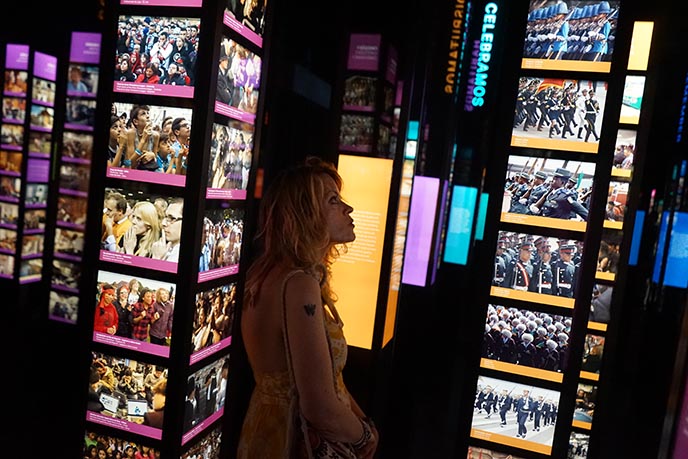
This cube had 1200 fascinating images arranged in pillars. They show global examples of prayers, sensations, relationships, power, body modifications and other human expressions.

The Museum of Tomorrow lets you reflect about our impact on the planet. These Stonehenge-like screens present real-time numbers about global gas emissions, ozone depletion, ocean population losses…

On the right, Daniel Wurtzel’s dancing fabrics convey the constant flux of matter. (No relation to Elizabeth, but the last name was a neat coincidence.)
By the end, you’re encouraged to think about the possibilities for transformation. We entered a wooden structure based on an indigenous longhouse, with an Australian “tjurunga” (symbolizing the passing on of knowledge) in the center. Music and lights mimic the cycles of sunset and sunrise.
At last, you emerge from the cocoon. As Elizabeth put it, “I am a purple butterfly looking into the future and everything is beautiful.”

The large picture-windows reconnect you to the present. Santiago Calatrava designed a reflection pool around the building with filtered water that is pumped in from the bay, and then released back.

A Frank Stella sculpture appears to float on the water. Hearts for the neofuturistic Museum of Tomorrow and its message of sustainability.

Our guide Rodrigo took us to the nearby mural by Eduardo Kobra. It’s the largest in the world, at 190 meters long.
The Brazilian street artist created this rainbow work for the Rio Olympic games.

The “Ethnicities” mural depicts five indigenous faces from five continents (Brazil, Ethiopia, Thailand, Northern Europe, and Papua New Guinea). They represent human ancestors and the colors of the rings on the Olympic flag.
Within a few years, “Olympic Boulevard” has become a tech center with green spaces, public events, live music and nightly fireworks.
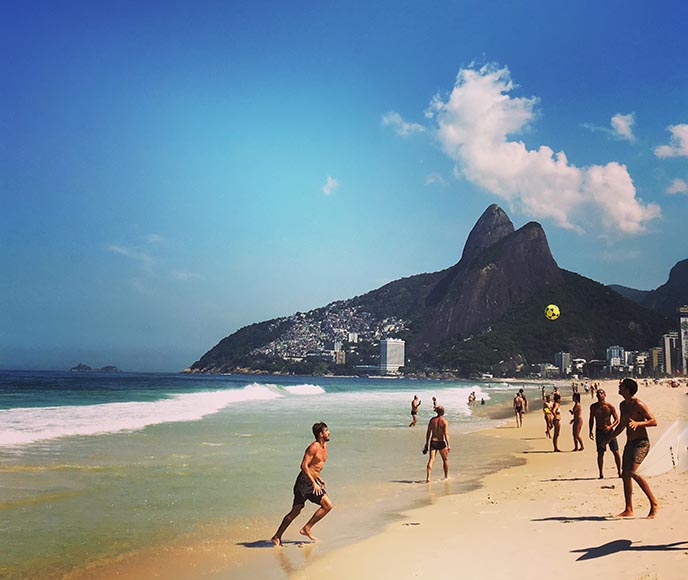
However, Rio’s beaches remain the heart of the city. Copacabana was favored by celebrities in the mid-20th century, but today, Ipanema beach is the place to be.
I loved walking by the ocean, especially on weekdays when Ipanema Beach is uncrowded. Groups gather in different “postos” or divisions; there are areas favored by hippies, LGBT, families, etc. You’ll come across groups of friends playing “football” (Brazil’s beloved national sport) and other games near the crashing waves.

I encourage you to book a hotel by the beach. My stay at Sofitel hotel let me live out my “girl from Ipanema” dreams: I only had to cross the street to have my feet in the sand.
(Book a stay at Sofitel Ipanema Rio here.)

The Sofitel made me feel at home with artistic interiors and surprise fruit plates, and staff that knew me by name. My 5-star room was decorated in mid-century modern tropicalia, with a picture-window that opened up to this view of Ipanema.

Every morning, I looked forward to Sofitel’s breakfast. You could choose from the buffet (the selection included a refreshing green detox juice, and coconut yogurt smoothies), or order from the menu (I always got the acai with banana, and tapioca crepe with cheese and vegetables).

We had lunch at the hotel’s 23 Ocean Lounge, located on a sunny terrace next to the swimming pool. We tried fresh cocktails made with Brazilian fruits, and ate local grilled fish followed by coconut mousse, while enjoying views of Ipanema and Copacabana beaches.

With a mod couch like this, waiting in the lobby was a pleasure! (Elizabeth is with Rodrigo, our outstanding local guide who also works as a TV fixer and speaks multiple languages.)

Sofitel Ipanema Rio de Janeiro is in the best possible location. You can walk over to the beachfront, or visit the fashion boutiques, cafes, jewelry stores and art galleries two blocks behind the hotel.

Most of the stores are on Rua Visconde de Pirajá. Brazilian fashion tends to be airy and relaxed. I was a fan of the footwear designers Melissa Shoes and Schutz Shoes; see below for some of their styles.

It was refreshing to be in a destination that doesn’t feel “touristy.” Very few people speak English in Brazil, even in major stores. I enjoyed the challenge of trying to communicate with hand gestures and bits of Portuguese!
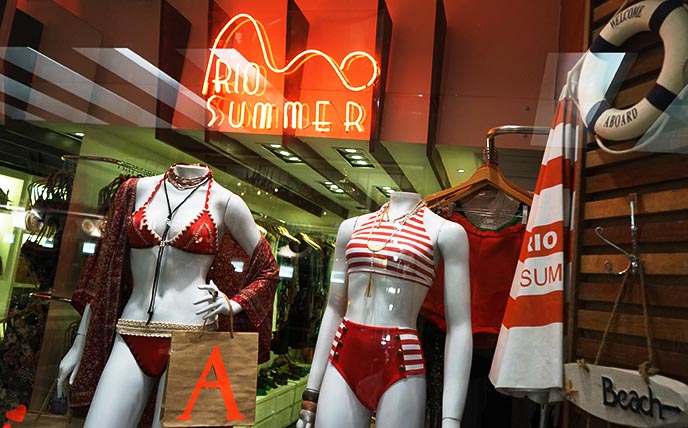
Rio de Janeiro is the place to shop for swimwear and resort fashion. (Find a similar red and white striped bikini here.)

Every Sunday, the road by Ipanema is closed to cars, which lets locals ride bikes, roller skate and walk along the shore. I strolled along the beach every day, and enjoyed the views (I’m talking about both the scenery and the fellows in it!)

Rodrigo recommended that we check out Botafogo, an up-and-coming neighborhood with outstanding restaurants, live music bars and nightlife.
We had dinner in this neighborhood, at Iraja Gastro — and it turned out to be one of the best meals I had in South America. Chef Camila Anacleto welcomed us to the cozy restaurant, known for its contemporary tasting menu with Brazilian influences.
We began with two addictive plates: mandioca (cassava) chips with grana padano and clarified butter, and churros of cheeses and herbs.

At Irajá Gastro, each dish is made with sustainable ingredients. Above is their latest version of caprese (it has gone through six variations so far): a brilliant combo of buffala mozzarella, basil oil, strawberry and tomato sorbet.

The open kitchen adds to the relaxed atmosphere of the restaurant. It’s a perfect place to have a special meal with friends, or celebrate an occasion.

We adored the fish of the day with toasted coconut and avocado. On the right: an innovative ravioli with fondant palm, chestnut and canastra cheese. Below it is my juicy Angus entrecote cut of the day, with mustard and vegetables. It paired perfectly with a bottle of red Guaspari (Iraja Gastro carries an extensive Brazilian-only wine list).

The meal had a sweet ending with a berry marshmallow dessert, and “bolo de brigadeiro” — hot chocolate cake with vanilla cream poured on top.
I recommend that you make a reservation at Iraja Gastro, and experience their menu for yourself.

A trip to Rio isn’t complete without seeing the spectacular view from the top of Sugarloaf Mountain (Pão de Açúcar). We rode cable cars up the two elongated mountains, which resemble traditional loaves of sugar.

Elizabeth and I took this photo from the top of the first mound, Urca Hill (Morro da Urca).
(I’m wearing Esqape sunglasses. and an Alex Streeter Morbid Debutante necklace. My dress is available for sale on my Depop, along with other items from my personal wardrobe.)

Visitors can walk around and take in the sights from 360 degrees.

When you’re ready to ascend the next peak, hop into the second glass-walled cable car. In three minutes, you’ll be at the top of Sugarloaf.

Do you see the crucifix-shaped silhouette on the mountain in the distance? That’s the famous statue Christ the Redeemer, on the peak of Corcovado. The 38-meter Jesus has his arms outstretched, and appears to be blessing the people from high above.
“Cristo Redentor” was completed in 1931 by French sculptor Paul Landowski and Brazilian engineer Heitor da Silva Costa. It’s the most recognizable landmark of Rio, and one of the New Seven Wonders of the World.

Both locals and visitors gather at the top of Sugar Loaf to take in this glowing sunset over Guanarana Bay. It’s one of the best spots in the city for golden hour.

Rodrigo then took us to the nearby Urca district, and ordered us caipirinhas (Brazil’s national cocktail, made with sugar, lime and cachaça — a sugarcane liquor). The seawall is a lively hangout spot for young locals, who play music and drink while watching the moon rise over the waterfront.

I also loved sipping tea and watching the pink skies from my window at Sofitel Ipanema hotel.

Elizabeth and I went outside to Ipanena beach for the last rays. Our trip to Rio was outstanding, and we’ll remember it for life.

It’s a great time to visit Brazil, as the complicated and expensive visa process has changed. In the past, you had to complete a detailed application that included bank statements and an employer’s letter, and leave your passport at the consulate for up to a month. Now, if you’re a citizen of Canada, United States, Japan, or Australia, the process is simpler. You can apply online for a Brazil tourist e-visa and receive it within a few days.

Obrigado LATAM Airlines for bringing me to South America for the first time, and Rio CVB and guide Rodrigo for showing us the best of your hometown.
Did you know Rio de Janeiro had such trippy, extraterrestrial attractions?
Time to fly off in my UFO… but more stories to come soon, including my dream journey to Easter Island!



 LA CARMINA
LA CARMINA






